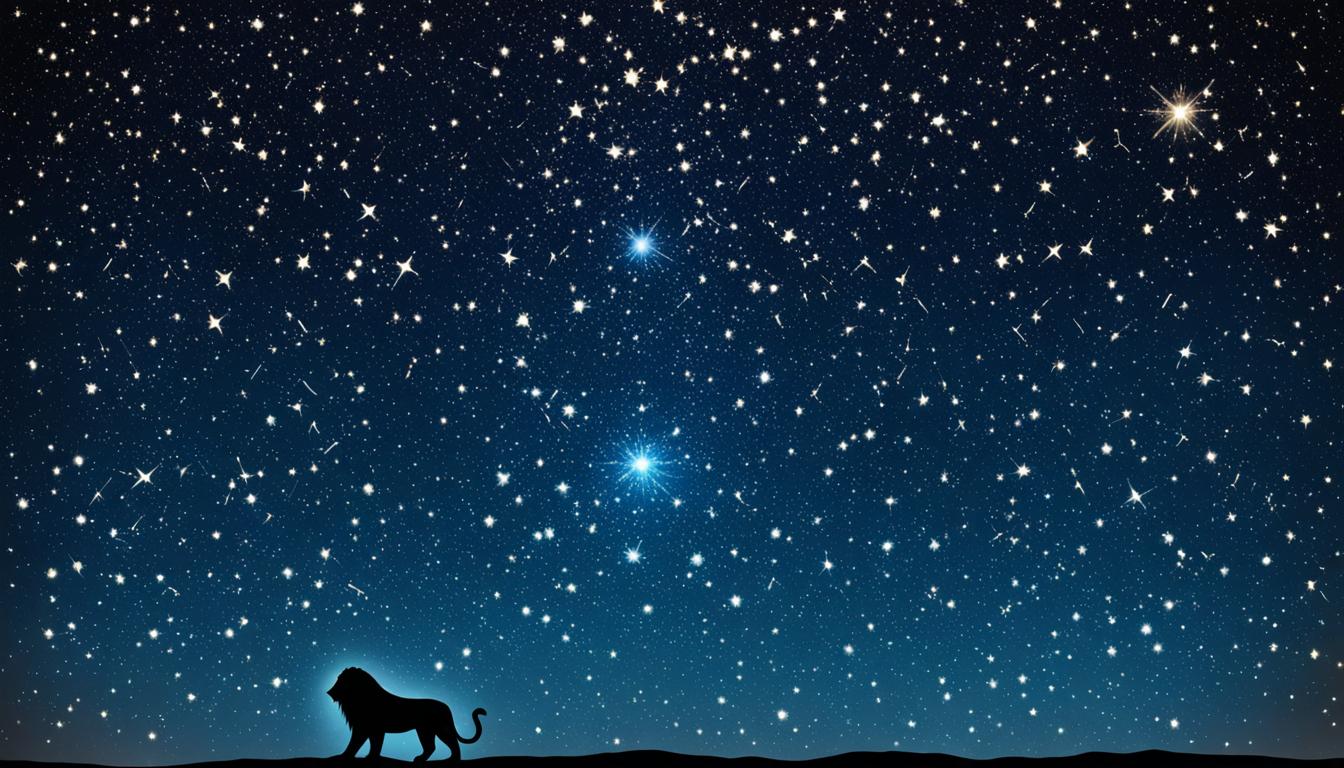| Genitive | |
| Abbreviation | |
| Pronunciation | |
| Main Stars | |
| Brightest Star | |
| Right Ascension | |
| Declination | |
| Sq. Deg. Area | |
| Crosses Meridian | |
| Visible Lat. Range |
Embark on a celestial journey through the stars and uncover the mysteries of the Constellation Leo. Steeped in astronomy and mythology alike, the lion-shaped constellation captivates observers with its bold presence in the night sky. Discover the Leo constellation meaning as you delve into the significance behind its legendary stance, representing the bravery and nobility of a lion. From historical narratives to celestial wonders, Leo’s story is as rich as the tapestry of stars that form its outline.
The prodigious constellation, documented by the Greek astronomer Ptolemy in the 2nd century, boasts an array of luminary spectacles. Its association with various cultures across time underscores the universal allure Leo holds. In these starlit pages, you are invited to explore the legacy and grandeur that has fascinated astronomers and stargazers for millennia.
As you venture through this comprehensive guide, prepare yourself to be immersed in not just an astronomical experience, but one that binds the threads of ancient lore to the vast expanse of the universe above you.
Key Takeaways
- Learn the ancient origins of the Leo constellation and its significance in various cultures.
- Unravel the meaning behind the Leo constellation, marrying celestial patterns with mythological might.
- Gaze upon the celestial wonders held within Leo, one of the most identifiable constellations in the sky.
- Explore the lion’s share of history that Ptolemy bestowed upon us through his early astronomical cataloguing.
- Discover why Leo has been an emblem of regality and courage throughout the ages.
- Acknowledge the brilliance of Leo’s stars, which have been guiding humans in the exploration of the nighttime sky.
A Glimpse into the Stars: Discovering Constellation Leo
As you trace the map of the night sky, the Leo star sign emerges as a beacon of cosmic storytelling and celestial grandeur. Understanding the Leo zodiac sign’s place in the astronomical tapestry enhances our appreciation of the universe’s wonders. This section will guide you through the notable features of Constellation Leo, including its size, location, the luminary Regulus, and the neighboring constellations in its celestial neighborhood.
The Lion’s Celestial Domain: Size, Location, and Mapping
Located strategically in the celestial hemisphere, Constellation Leo is a prominent figure in the NQ2 quadrant, delineated by various astronomical neighbors. Your journey in locating Leo commences with identifying its borders and recognizing it as one of the grandest constellations to grace our skies.
| Feature | Description |
|---|---|
| Location in Sky | Northern Celestial Hemisphere |
| Visible Latitudes | +90° to -65° |
| Size | 947 Square Degrees |
| IAU Abbreviation | Leo |
| Brightest Star | Regulus (Alpha Leonis) |
Regulus: The Heart of the Lion
Regulus, the Alpha Leonis, crowns the constellation as the brightest star in Leo, pivotal for celestial navigation and a cornerstone in the fabric of astronomical heritage. A closer look at this stellar entity reveals its unique astrophysical properties, making it not just a point of light, but a landmark of cosmic significance.
Owing to its luminosity and distance from Earth, Regulus is an object of fascination for both seasoned astronomers and casual stargazers alike. Its rapid rotation and resultant oblate shape make it a celestial phenomenon that captures the imagination, representing the mythological heart of the celestial lion.
Neighboring Constellations: Navigating the Celestial Landscape
The Leo zodiac sign does not stand alone. Its location maps it among a myriad of neighboring constellations, each with its own story and presence in the celestial sphere. Together, they form a geographical expanse that enriches our understanding of space and our place within it.
Constellation Leo, with its majestic presence and astronomical significance, invites you to explore the cosmic expanse, offering both a sense of scale and a connection to the mythos engraved in the stars.
The History and Mythology of Leo: From Ancient Cultures to Modern Interpretations
Delving into the Leo mythology, you uncover a narrative that has captivated human fascination since ancient times. Trace the roots back to 4000 BC, and you’d find the Mesopotamians looking up at a lion-shaped constellation, very much the progenitor of our contemporary Leo. This celestial symbol of a lion was not unique to Mesopotamia; it echoed across ancient cultures, each interpreting and naming it in the language of their times and tales.
For the Babylonians, it was UR.GU.LA, “the great lion,” while the Persians knew it as Shir or Ser. These varying appellations shared a common theme—the lion’s embodiment of royal might and valor. At the heart of these stories gleamed Regulus, known as “the star that stands at the Lion’s breast”—a moniker that personified its prestige as the King Star.

The Nemean lion, a cornerstone of Greek mythology, further integrates the constellation into the collective mythos of ancient civilizations. A beast of impossible strength, it was said that no weapon could dent its golden hide. Lion imagery associated with this myth reinforces the notion of invincibility and indomitable spirit that Leo symbolizes in astrological and cultural lore.
| Culture | Name for Leo | Associated Mythological Creature |
|---|---|---|
| Mesopotamian | Lion Constellation | Great Celestial Lion |
| Babylonian | UR.GU.LA | The Great Lion |
| Persian | Shir/Ser | Royal Lion |
| Greek | Leo | Nemean Lion |
These narratives, deeply etched in the past, continue to shape modern interpretations and understandings. As you look up at the night sky, the Leo constellation serves as a vessel for timeless stories—a celestial canvas painted with strokes of ancient cultures, heroism, and the universal human quest for meaning amongst the stars.
Principal Stars of Leo: A Detailed Look
As you gaze into the skies, the constellation of Leo offers a galactic spectacle with its assembly of brilliant stars. At the forefront of this celestial showcase is Regulus, often denoted as Alpha Leonis, whose attributes have fascinated astronomers and stargazers alike. Before delving into the individual stars that give Leo its regal glow, let’s first center our attention on the illustrious Regulus, a spectroscopic binary star that stands out as the constellation’s linchpin.

Unveiling Regulus: An In-depth Analysis of Alpha Leonis
At the heart of Leo lies Regulus, the brightest star within the constellation and a stellar masterpiece in its own right. This spectroscopic binary star flaunts a primary component lauded for its rapid rotation rate. This velocity is so significant it shapes the star into an oblate spheroid, distinguishing it from many other stars viewed in the night sky. The Regulus system is complex, featuring a companion star thought to be a white dwarf, which together reflects the dynamic nature of these celestial beings.
Denebola and Algieba: Exploring Key Luminaries
Following Regulus, Denebola—or Beta Leonis—claims its place as the second brightest star in Leo. This main sequence star, located some 36 light-years away, is a testament to the diverse stellar architecture of the constellation. Algieba, known as Gamma Leonis, presents itself as a double star system, adding depth to our understanding of the cosmos with its golden-yellow giant and its less luminous partner star.
Zosma and Chort: Uncovering Lesser-Known Stars
Further enriching the tapestry of Leo, Zosma—or Delta Leonis—offers a glimpse of a white main sequence star, famed for its high rotational velocity. Not to be overlooked, Chort, the name given to Theta Leonis, emerges as another white star, contributing to the constellation’s lore with its spectral classification of A2 V. Each star, from the renowned Regulus to the more subdued Chort, plays a pivotal role in crafting the magnificent semblance of the Lion in the cosmos.
| Star Name | Designation | Distance (light-years) | Apparent Magnitude | Spectral Type |
|---|---|---|---|---|
| Regulus | Alpha Leonis | 77 | 1.35 | B7 V |
| Denebola | Beta Leonis | 36 | 2.113 | A3 V |
| Algieba | Gamma Leonis | 130 | 2.00 (combined) | K0 III-IV + G7 III |
| Zosma | Delta Leonis | 58.4 | 2.56 | A4 V |
| Chort | Theta Leonis | 165 | 3.33 | A2 V |
Astronomical Insights: Leo’s Deep Sky Wonders
As you venture deeper into the expanse of the Leo constellation, you’ll discover a treasure trove of deep sky objects that are more than merely points of light. Among these celestial phenomena are the Messier objects, a collection named after French astronomer Charles Messier, which includes some of the most studied galaxies in the night sky.
Messier Objects: A Tour of Leo’s Galactic Landscapes
Messier 65, Messier 66, Messier 95, Messier 96, and Messier 105 are galaxies that not only offer a glimpse into the vastness of our universe but also represent significant cosmic landmarks within the boundaries of the Leo constellation. Each of these NGC galaxies stands as a testament to the ever-expanding canvas of the cosmos, measured in astronomical units that boggle the mind. Their spiraling arms and luminous cores are a testament to the ongoing celestial dance of creation and evolution.
These famed celestial bodies are observable with the aid of a telescope and reveal a fascinating story of not just their own existence, but also the history of our observation of the night sky. For both amateur and professional astronomers alike, the Messier objects within Leo are a source of wonder and scientific discovery.
The Mysterious Leo Ring: Unraveling Celestial Phenomena
In the realm of astronomical mysteries, the Leo Ring compels special attention. This giant cloud of hydrogen and helium gas takes the form of a large ring-like structure orbiting two NGC galaxies. Its presence poses compelling questions about the origins and dynamics of such astral formations. The Leo Ring, reflecting light over millions of years, offers a peek at the primal elements that gave birth to galaxies and ultimately, our own star, the Sun.
Engage with the enigmas of the Leo Ring and consider the forces that sculpt the vast tapestry of space—a celestial phenomenon that’s both confounding and captivating for those who gaze upon it. As you explore the night sky, remember that such wonders are a legacy of an astronomical heritage that spans eons, awaiting your discovery.
Leo and Astrology: Deciphering the Zodiac’s Influence
As you delve into the world of astrology, the Leo star sign emerges as a symbol of natural leadership, pride, and an almost magnetic charisma. It isn’t surprising that individuals born under this sign are commonly associated with a lion’s might and regal demeanor—a cosmic reflection of Leo’s bright and fiery spirit. With their robust personalities, those ascribed to Leo astrology often exude confidence and a zest for life that is as infectious as it is inspiring. Leo personality traits suggest a penchant for being at the center stage, dynamically leading with both heart and strength.
Leo Horoscope Impact: Personality Traits and Compatibility
Your Leo horoscope might highlight an intriguing dance of interpersonal dynamics, emphasizing Leo compatibility with other zodiac signs. Often seen orchestrating the rhythms of their social spheres, Leos thrive on mutual respect and admiration. Relationships governed by Leo characteristics are built on loyalty and a warm, generous spirit. If you identify with this sign, you may find that your horosopic guidance leans towards seeking out partnerships that value your inherent courage and vitality—both in platonic and romantic spheres.
Leo’s Symbolic Significance: Embracing the Mythological Essence
Leo symbolism weaves a rich narrative through the tapestry of astrology and myth. Embracing the symbolic significance of Leo within astrology allows for a broader understanding of your foundational make-up. Known for its grandeur and bravery, Leo embodies the valiant tales and kingly traits canonized by ancient civilizations. This zodiac’s imprint on today’s interpretations of character and destiny are as profound as they are storied, reinforcing a narrative of nobility that continues to echo throughout the astrological community.
FAQ
What is the Constellation Leo and what does it represent?
The Constellation Leo is one of the twelve zodiac constellations, named after the Latin word for lion. It represents strength, royalty, and courage, embodied by the figure of a lion, and is steeped in rich mythology and history, tracing back to ancient cultures such as the Mesopotamians and Greeks.
Where is Constellation Leo located in the sky?
Constellation Leo can be found in the northern celestial hemisphere, covering 947 square degrees. It is visible at latitudes between +90° and -65° and situated within the NQ2 quadrant bordered by constellations such as Cancer, Virgo, and others.
Who catalogued Constellation Leo and when?
The ancient Greek astronomer Ptolemy first catalogued the Constellation Leo in the 2nd century, alongside other zodiac constellations.
What is significant about the star Regulus?
Regulus, or Alpha Leonis, is the brightest star in Leo and the 22nd brightest in the night sky. It is a blue-white main-sequence star about 77 light years from Earth and known for its fast rotation speed, which gives it an oblate shape. Regulus has historical significance, often called the King Star, and reflects Leo’s themes of royalty and strength.
Can you name the main stars in the Constellation Leo?
The main stars in Constellation Leo include Regulus (Alpha Leonis), Denebola (Beta Leonis), Algieba (Gamma Leonis), Zosma (Delta Leonis), and Chort (Theta Leonis), among others. These stars range from bright main sequence stars to double star systems and giants, adding to the constellation’s brightness and reputation in the sky.
What are the Messier Objects in Leo, and why are they significant?
Leo contains several Messier objects, which are notable galaxies like Messier 65, Messier 66, Messier 95, Messier 96, and Messier 105. These objects showcase the rich galactic presence within Leo’s boundaries and are significant for astronomers as they offer a glimpse into the structure and composition of the Universe.
What is the Leo Ring?
The Leo Ring is a massive structure composed of hydrogen and helium gas shaped in a ring, orbiting two galaxies within Leo’s vicinity. This interstellar phenomenon is a subject of astronomical interest because it holds clues to the processes of galaxy formation and evolution.
What are some personality traits associated with the Leo zodiac sign?
People born under the Leo zodiac sign are often associated with traits such as boldness, exuberance, leadership, and confidence. They are thought to possess a natural charisma and a desire for recognition, reflecting the regal and powerful nature of the lion.
How does the Leo constellation contribute to astrology and horoscopes?
In astrology, the Leo constellation has a significant influence on horoscopes, shaping personality traits and compatibility with other zodiac signs. It symbolizes strength, leadership, and generosity, and these characteristics are often reflected in the interpretations of individuals’ horoscopes who are born under the Leo sign.
What does the Leo constellation mean historically?
Historically, the Leo constellation has been linked to the symbol of a lion across different civilizations, signifying majesty, power, and divine authority. It has been recognized under various names, all meaning ‘lion’, in ancient societies such as Babylonian, Persian, and others, and is notably associated with the Nemean lion defeated by Heracles in Greek mythology.






